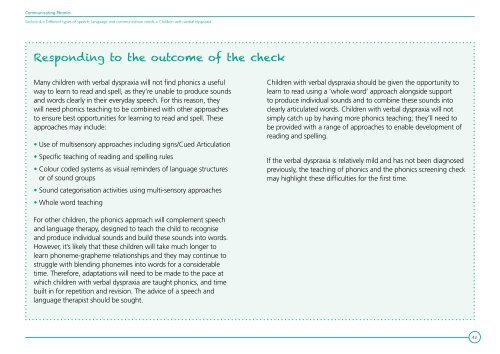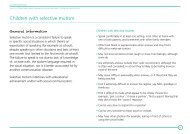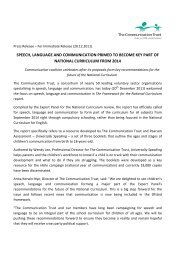Communicating Phonics - The Communication Trust
Communicating Phonics - The Communication Trust
Communicating Phonics - The Communication Trust
Create successful ePaper yourself
Turn your PDF publications into a flip-book with our unique Google optimized e-Paper software.
<strong>Communicating</strong> <strong>Phonics</strong>Section 4 > Different types of speech, language and communication needs > Children with verbal dyspraxiaResponding to the outcome of the checkMany children with verbal dyspraxia will not find phonics a usefulway to learn to read and spell, as they’re unable to produce soundsand words clearly in their everyday speech. For this reason, theywill need phonics teaching to be combined with other approachesto ensure best opportunities for learning to read and spell. <strong>The</strong>seapproaches may include:• Use of multisensory approaches including signs/Cued Articulation• Specific teaching of reading and spelling rules• Colour coded systems as visual reminders of language structuresor of sound groups• Sound categorisation activities using multi-sensory approaches• Whole word teachingChildren with verbal dyspraxia should be given the opportunity tolearn to read using a ‘whole word’ approach alongside supportto produce individual sounds and to combine these sounds intoclearly articulated words. Children with verbal dyspraxia will notsimply catch up by having more phonics teaching; they’ll need tobe provided with a range of approaches to enable development ofreading and spelling.If the verbal dyspraxia is relatively mild and has not been diagnosedpreviously, the teaching of phonics and the phonics screening checkmay highlight these difficulties for the first time.For other children, the phonics approach will complement speechand language therapy, designed to teach the child to recogniseand produce individual sounds and build these sounds into words.However, it’s likely that these children will take much longer tolearn phoneme-grapheme relationships and they may continue tostruggle with blending phonemes into words for a considerabletime. <strong>The</strong>refore, adaptations will need to be made to the pace atwhich children with verbal dyspraxia are taught phonics, and timebuilt in for repetition and revision. <strong>The</strong> advice of a speech andlanguage therapist should be sought.43
















